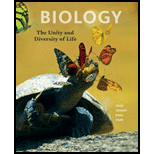
Concept explainers
The type of physical environment in which a species typically lives is its _______.
- a. niche
- b. habitat
- c. community
- d. population
Introduction: The branch of science that deals with the study of the relations among organisms and their physical environment. A group of species that lives in the same geographical place at a specific time is known as community.
Answer to Problem 1SQ
Correct answer: The type of physical environment in which a species typically lives is its habitat.
Hence, the correct answer is option b.
Explanation of Solution
Reason for the correct answer:
The place or the environment in which all the species naturally live and consists of all the biological and physical features that are accessible to a species is known as habitat. All the species living in a specific habitat comprises a community.
Option b. is given as “habitat”.
The place or the environment in which all the species naturally live is known as habitat.
Hence, the correct answer is option b.
Reason for the incorrect answer:
Option a. is given as “niche”.
The role played by the species in order to meet their needs in its community is known as ecological niche. Niche is not the physical environment in which the species lives naturally.
Hence, option a. is incorrect.
Option c. is given as “community”.
A group of species that lives in the same geographical place at a specific time is known as community. All the species living in a specific habitat comprises a community. The community is not the type of physical environment in which the species lives naturally.
Hence, option c. is incorrect.
Option d. is given as “population”.
The number of organisms that live together in the same area is called population. Population is not the physical environment in which the species lives naturally.
Hence, option d. is incorrect.
Therefore, options a., c., and d. are incorrect.
The habitat is a type of physical environment in which the species lives naturally.
Want to see more full solutions like this?
Chapter 45 Solutions
Biology: The Unity and Diversity of Life (MindTap Course List)
Additional Science Textbook Solutions
Campbell Essential Biology with Physiology (5th Edition)
Campbell Essential Biology (7th Edition)
Campbell Biology (11th Edition)
Microbiology: An Introduction
Concepts of Biology
Microbiology: Principles and Explorations
- The type of place where a species typically lives is called its _______. a. niche c. community b. habitat d. populationarrow_forwardIntraspecific competition reduces allelic diversity by Select one: a. relieving predator pressure on the prey population b. allowing K-selected species to have a selective advantage over r-selected species c. creating a competitive advantage to certain alleles d. allowing two different species occupying the same niche to compete for resourcesarrow_forwardWhy does the aquarium trade contribute to the introduction of nonnative species? a. Exotic species can escape or be released into local ecosystems. b. Aquarium owners do not always understand how ecosystems interact. c. Nonnative fish are shipped worldwide for aquariums. d. All of the above Please select the best answer from the choices provided A B C Darrow_forward
- A researcher investigating how pesticides and water temperature impact the density of phytoplankton in freshwater lakes is primarily focused on ____________ ecology. Group of answer choices A. community B. ecosystem C. biosphere D. population E. organismalarrow_forwardA(n) ________ ecologist studying frogs would examine the preferred nesting locations of frogs. A. Population B. Organismal C. Communityarrow_forwardWhich of the following is an example of an ecological population? a)All organisms living in a forest b)All mammals in a forest c)A family of deer within a forest d)All members of a single deer species in a forestarrow_forward
- If you are studying the changes in the panda population in Asia you are most likely considered a…. a. Population ecologist b. Ecosystem ecologist c. Global Ecologist d. Community ecologistarrow_forwardWhich of the following is not a way that humans have increased the carrying capacity of the environment? a. agriculture b. using large amounts of natural resources c. domestication of animals d. use of languagearrow_forwardPopulation _______________ is the number of individuals of a species per unit of habitat area or volume at a given time. (a) dispersion (b) density (c) survivorship (d) age structure (e) demographicsarrow_forward
- The elimination of predators by humans a. will cause its prey to experience exponential growth until new predators arrive or evolve. b. will lead to an increase in the carrying capacity of the environment. c. may increase the population size of a prey species if that prey’s population was being regulated by predation from the predator. d. will lead to an Allee effect.arrow_forwardWhen a population of organisms is evolving, what can you be sure is happening? a. No change is occurring b. It is improving c. It is becoming more human-like d. It is changingarrow_forwarddescribes the positive benefits that wildlife or ecosystems provide to people. A. Biodiversity B. Ecosystem services C. Culture D. Habitat preservationarrow_forward

 Biology: The Dynamic Science (MindTap Course List)BiologyISBN:9781305389892Author:Peter J. Russell, Paul E. Hertz, Beverly McMillanPublisher:Cengage Learning
Biology: The Dynamic Science (MindTap Course List)BiologyISBN:9781305389892Author:Peter J. Russell, Paul E. Hertz, Beverly McMillanPublisher:Cengage Learning Concepts of BiologyBiologyISBN:9781938168116Author:Samantha Fowler, Rebecca Roush, James WisePublisher:OpenStax College
Concepts of BiologyBiologyISBN:9781938168116Author:Samantha Fowler, Rebecca Roush, James WisePublisher:OpenStax College Biology (MindTap Course List)BiologyISBN:9781337392938Author:Eldra Solomon, Charles Martin, Diana W. Martin, Linda R. BergPublisher:Cengage Learning
Biology (MindTap Course List)BiologyISBN:9781337392938Author:Eldra Solomon, Charles Martin, Diana W. Martin, Linda R. BergPublisher:Cengage Learning Human Biology (MindTap Course List)BiologyISBN:9781305112100Author:Cecie Starr, Beverly McMillanPublisher:Cengage Learning
Human Biology (MindTap Course List)BiologyISBN:9781305112100Author:Cecie Starr, Beverly McMillanPublisher:Cengage Learning




